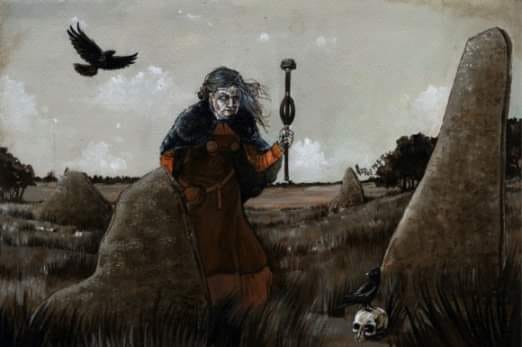
From totemic baton to sceptre, and from cursing rod to distaff, a shaft of wood or metal has been raised in the hands of women across the globe for thousands of years. Plain, crooked or carved, and bedecked with various impedimenta; fashioned in bone, skin, wood and metal, the phallic rod has perhaps attracted more attention than any other tool associated with magic and the Female Mysteries. Because of this, ‘wands’ became perceived almost universally as the magical tool par excellence, an imperative that assured their manifest survival within the veiled symbology of both secular and religious spheres, as a Tool of Office, celebrity or status. Historical precedents clearly inspired this gravid image of a Völur raising her Seiðr staff.
Seiðr is rooted through its etymology to Old High German terms relating to fetters and to bindings in all its forms. Halters, cords, withies, spun threads, snares and knots are used for enchantment and the manipulation of Wyrd, especially when combined with the distaff, which is not only symbolic of the Völur’s status, but is also the equivalent of the now familiar oaken stave used by warrior shamen.
Several examples occur throughout the sagas that imply a link between Seiðr magics and the winds generated by the scared breath or onð. Animal forms become the sorcerers ‘mind-emissary,’ and may be regarded as a snare, sent forth to ‘catch,’ or entangle its victim (prey), by twisting and wrapping around it, like a wind, specifically, a whirlwind. This is very much based in the principle of animism – articulated through a great many beliefs regarding the spirits of the wind, thunder and storm especially.








